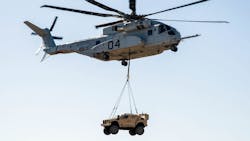Sikorsky to build 12 new CH-53K heavy-lift helicopters and avionics for U.S. Marines in $1.13 billion order
PATUXENT RIVER NAS, Md. – Engineers at Sikorsky Aircraft Corp. in Stratford, Conn., will build 12 new CH-53K King Stallion heavy-lift helicopters and integrated avionics systems for the U.S. Marine Corps under terms of a $1.13 billion billion order announced Friday.
Officials of the U.S. Naval Air Systems Command at Patuxent River Naval Air Station, Md., are asking Sikorsky, a Lockheed Martin company, to build 12 Lot II and Lot III low-rate initial production CH-53K helicopters, including logistics and support equipment. These helicopters are part of 200 planned for the Marines.
The CH-53K King Stallion is a large heavy-lift cargo helicopter designed to replace the Marine Corps fleet of CH-53E heavy-lift helicopters to help move Marines and their equipment from ships offshore onto attack beaches. The CH-53K is a general redesign of the CH-53E.
The CH-53K sea-based, long range, heavy-lift helicopter is designed to provide three times the lift capability of its predecessor. The CH-53K will conduct expeditionary heavy-lift transport of armored vehicles, equipment, and personnel to support distributed operations deep inland from a sea-based center of operations, Sikorsky officials say. It can lift more than 18 tons.
The CH-53K will have new engines and cockpit avionics layout, and will have more than twice the lift capacity and combat radius of the CH-53E. A wider cargo hold to enable the new aircraft to carry a light combat vehicle internally, and will have new composite rotor blades. It will use the General Electric GE38-1B engine.
Related: King Stallion: the future of U.S. Marine Corps heavy lift helicopters for airborne resupply
It can operate at high altitudes, hot temperatures, and in degraded visual conditions; sling load 36,000 pounds; can fly faster than 200 knots; can make 60-degree-angle bank turns; can climb to 18,500 feet above sea level; conduct 12-degree slope landings and takeoffs; and can auto-jettison external loads, and survive gunfire.
The CH-53K first flew in late 2015, and the helicopter was introduced to Marine Corps squadrons last year. The Marines plan to buy 227 CH-53K helicopters for about $23.3 billion.
Rockwell Collins in Cedar Rapids, Iowa, is providing the CH-53K's avionics management system; Sanmina-SCI Corp. in San Jose, Calif., is providing the new helicopter's intercommunications System; and Spirit AeroSystems in Wichita, Kan., is providing the CH-53 cockpit and cabin. Other major subcontractors are GKN Aerospace in Redditch, England; and Onboard Systems International in Vancouver, Wash.
Rockwell Collins is providing the company's Common Avionics Architecture System (CAAS) for the CH-53K. The CAAS integrates several communications, navigation and mission subsystems through its Flight2 system. It uses common reusable processing elements in an open-systems architecture based on commercial standards.
Related: Eaton to supply CH-53K helicopter cockpit control panels, dimming controllers
The Rockwell Collins CAAS avionics initially was developed for the Special Operations Forces' MH-47 and MH-60 helicopter fleets. In addition to the CH-53K, CAAS avionics also has been selected for the CH-47F, MH-60T, MH-65E, and VH-60N aircraft.
The Sanmina-SCI FireComm Intercommunications Control System for the CH-53K uses digital processing techniques and controls. Its system architecture uses the MIL-STD-1553 avionics data bus; the IEEE 1394b data bus; 10/100 Base-T Ethernet; and TIA/EIA-485 interface ports.
On this order Sikorsky will do the work in Stratford, Conn.; Wichita, Kan.; Salt Lake City.; Hazelwood, Mo.; Bridgeport, W.Va.; Windsor Locks, Conn.; Redmond, Wash.; Rochester and Wolverhampton, England; Quebec City; Kent, Wash.; Cudahy, Wis.; Fort Walton Beach, Fla.; Rome, N.Y.; and at other locations inside and outside of the Continental U.S., and should be finished by December 2023.
For more information contact Sikorsky Aircraft online at www.lockheedmartin.com/en-us/capabilities/sikorsky.html, or Naval Air Systems Command at www.navair.navy.mil.
About the Author
John Keller
Editor-in-Chief
John Keller is the Editor-in-Chief, Military & Aerospace Electronics Magazine--provides extensive coverage and analysis of enabling electronics and optoelectronic technologies in military, space and commercial aviation applications. John has been a member of the Military & Aerospace Electronics staff since 1989 and chief editor since 1995.
